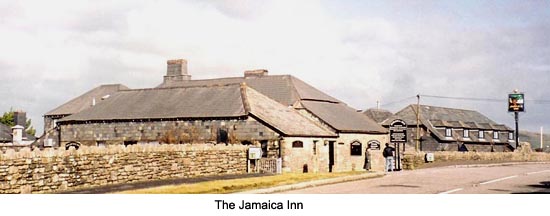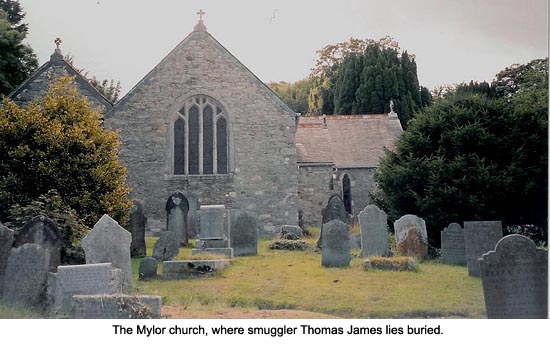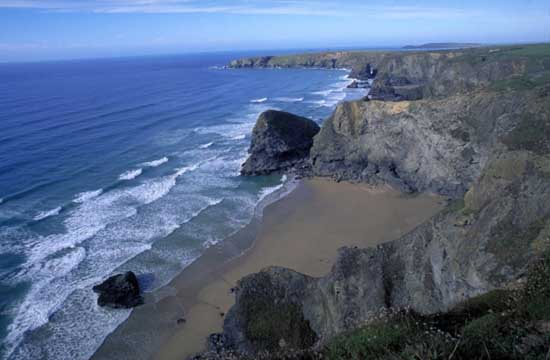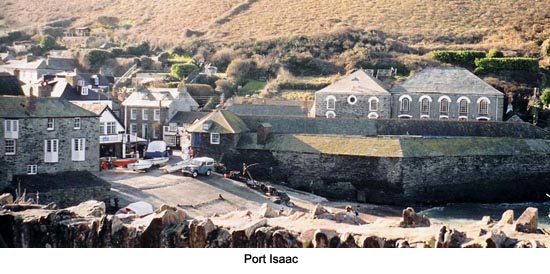On the Trail of Cornwall's "Free Traders"
by Grant Eustace
Daphne du Maurier used her beloved Cornwall as a backdrop for
several of her novels, and the sea, and particularly smuggling,
was at the heart of two of them. While they may have been
fiction, they were rooted in fact, and set in real places.
Frenchman's Creek is one of the inlets on the Helford
river, in the eastern side of the Lizard peninsula. The whole of
the Helford is peaceful and attractive, with picturesque villages
of ancient lineage on its banks: Manaccan, Gweek, and Helford
itself.

Jamaica Inn is still standing, and still functioning
with accommodation, bar and restaurant, at Bolventor on the main
A30 road as it crosses Bodmin Moor. It was built in the
mid-eighteenth century as a coaching inn, providing a haven for
travellers crossing what can still seem a forbidding stretch of
country. Daphne du Maurier herself stayed there in 1930, which
was what prompted the novel. Today there is also a collection of
smuggling artefacts at the Inn.
Each book title highlights one of the key aspects of successful
smuggling. Secluded locations, where Revenue officers patrol
only sporadically, if at all, are ideal for putting cargoes
ashore. And temporary storage, again out of choice in isolated
places, is required to hide the contraband from prying eyes until
it can be divided up and distributed. Typical of these, apart
from Jamaica Inn itself, is a farm close to a creek on the Fal
river, which was known as "a good depot, where landed kegs were
carried up a sunken road, and hidden in caves or in the
woods."
The smuggling of illegal goods -- drugs, immigrants, endangered
species -- is a relatively recent phenomenon. In the past, it
was usually the excise duties demanded by a greedy government,
even on everyday commodities like salt (as well as luxury items
such as silk clothing) which made it worthwhile for smuggler and
purchaser alike to run the risks of evading them. So it was in
the main period of Cornwall's smuggling, which was between
approximately 1700 and 1850. Its peak was in the second half of
the 18th century.
In 1783, for instance, a Government committee reported that there
were "considerable" vessels (meaning of some three hundred tons)
able to make "seven or eight voyages a yearΙ the largest of them
can bring, in one freight, the enormous quantity of three
thousand half-ankers of spirits, and ten or twelve tons of tea."
(The half-anker was a container holding four and a half gallons.)
Tobacco was another favourite commodity -- as the traditional
poem has it: "brandy for the parson, baccy for the clerk." It was
said in 1784 that for every ounce of tobacco sold legally, one
pound was smuggled.
Nor were those officials commenting on anything out of the
ordinary. Some eighteen years earlier, a legitimate tradesman
had noted that his employees encountered "sixty horses having
each three bags of tea on them of 56 or 58 pounds weight... landed
on a beach two miles to the west of Padstow." (Padstow, on the
north coast of Cornwall, is a bustling small port now best known
for its fashionable and much-frequented fish restaurants.)

The mention of beaches highlights the virtually insuperable
problem that faced those trying to enforce the law. Small
tree-lined creeks, like those along the rivers of the south coast
of Cornwall, were difficult enough to police -- and they were
certainly used extensively for smuggling. Places such as Mylor
Creek, for example, which feeds into Falmouth's great natural
harbour of Carrick Roads. Mylor is still reached only by boat or
by a succession of descending narrow lanes off the A39, but is
worth the detour. The graveyard of its ancient church contains
the grave of one Thomas James, a smuggler shot by Customs
officers, as well as the largest Celtic cross found in Cornwall.
(Don't be misled by the mere ten feet that are visible -- there
are another seven in the ground.)
But the nub of the problem for the authorities was the long,
sparsely-inhabited Cornish coastline and its many coves. While
they had a justifiably fearsome reputation at high tide in a
gale, since there were innumerable rocks that even now will rip
steel hulls to shreds, at calm low water many of them have broad,
gently shelving stretches of sand that were ideal for bringing
small boats ashore to meet the waiting strings of ponies. Some
beaches, indeed, were employed that way for above-board commerce.
Trebarwith Strand, on the north coast between Tintagel and Port
Isaac, for example, was used in the 19th century to load slate
from the nearby quarries.
 > >
Visitors can go to all of these places simply for their
breathtaking beauty, and on the north coast to surf as well. But
many of them, such as the dramatic pair Kynance and Mullion on
the Lizard peninsula, were associated with smuggling, and one or
two achieved particular notoriety. Prussia Cove, situated where
the Lizard in the north-west turns into the broad sweep of
Mount's Bay, was one. This description of it could suit a hundred
others: "a spot so sheltered and secluded that it is impossible
to see what boats are in the little harbour until one literally
leans over the edge of the cliff above".
From 1770 to 1807, the extraordinary Carter brothers -- of whom
one, John, adopted the title of King of Prussia, although he
often demurred to his sibling Captain Harry -- operated primarily
from Prussia Cove. Although their combining a real trade of
fishing with smuggling clearly put them well outside the law,
they were devout Methodists who allowed no swearing among their
crew. When one of their cargoes was seized, they 'released' it
again by raiding the Penzance Customs House. But they took only
their own cargo, leaving undisturbed the contraband that
'belonged' to others.

So daring did many smugglers become that they sometimes
ignored that requirement for an isolated place in which to land
their cargoes. Most of the coastal harbours that, again,
tourists visit now because of their attractiveness had active
smugglers among their inhabitants: Polperro, St Mawes, Fowey and
Mevagissey on the south coast, Boscastle, Newquay and Hayle on
the north. Port Isaac, also on the north coast, and a port long
before the pier was built in the 16th century, has an association
with another smuggler -- but one more legend than fact,
delighting in the name of Cruel Copinger.
Nor were smugglers always as careful as they might have been when
it came to storing their contraband, often simply choosing the
public houses in which they did their regular drinking. The
'Bush' in Morwenstowe, the 'Dolphin' in Penzance, the 'Ship' in
Porth Leven and 'The Jolly Sailor' in Looe are among those where
a present-day visitor might stop for a drink and not necessarily
realise the strong associations with smugglers. In the last of
these, indeed, the landlady is supposed to have sat upon a keg of
contraband brandy while Revenue officers searched in vain.
This can make smuggling sound like a game -- especially when you
read of other stories, such as an incident in 1831. A Revenue
cutter followed a 'hot lead' and arrested a boat which they
brought into Bude (on the north Cornish coast), only to find it
was full of nothing but salt herring. But there were times when
it became deadly serious. In 1827, for example, a fairly brazen
run of contraband into the area of Falmouth harbour was
intercepted and the cargo seized. The 'free traders,' reportedly
some thirty strong, retaliated and took back their 'possessions,'
with shots exchanged and one Customs officer beaten unconscious
and left for dead.
Yet despite the mutual antagonism, humanity could still take
precedence over ancient feuds. On a freezing December night in
1805, two Excise officers were travelling on the south-western
edge of that same Bodmin Moor where Jamaica Inn is situated. They
got hopelessly lost, and eventually stopped exhausted. They
would have died of exposure if two local tin miners had not
happened across them, and brought them to safety.
Then, as now, Cornish hospitality won out.
Related Articles:
- Parsons, Scarecrows and Fear: Kent's Smuggling Heritage, by Richard Crowborough
- https://www.timetravel-britain.com/articles/country/smuggling.shtml
More Information:
We regret that we no longer have the resources to maintain up-to-date links and/or hours and pricing details for the various sites and attractions listed on this website. For more information about the location(s) listed above, please use your favorite search engine or visit Wikipedia.
Grant Eustace is a professional writer active in a
variety of fields, from film and video through print to radio
and on-line content, the last two of these principally for the
BBC World Service. He also works with -- and speaks regularly at
international gatherings of -- the Tourism and Cultural Identity
Committee of the World Trade Centers Association.
Article and photos © 2006 Grant Eustace
Coast photo courtesy of Britainonview.com
|
